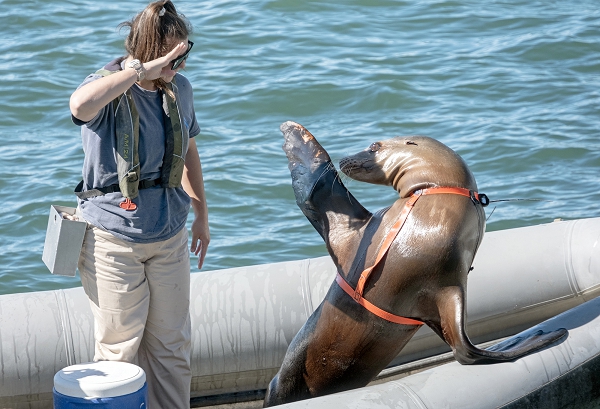
San Diego, California. (November 7, 2024): Who is better at helping U.S. Sailors and Marines deal with underwater threats than the highly intelligent creatures that call the deep their home? In this photo by Todd Hack, a scientist signals a sea lion to salute during an exhibition as part of Fleet Week held here this week. Fleet Week is a great opportunity for service members to participate in various community relations events, showcase their military capabilities and equipment, and enjoy local hospitality.
The Naval Information Warfare Center, through its Marine Mammal Program, has trained dolphins and sea lions as workmates since the 1960s. These highly intelligent animals are trained to detect, locate, mark, and recover objects in harbors, coastal areas, and at depth in the open sea.
California sea lions (Zalophus californianus) are coastal seals native to western North America that are particularly accustomed to working with humans. They have excellent low light vision and underwater directional hearing that allows them to detect and track undersea targets, even in dark or murky waters. These large, imposing beasts also function as security by detecting and helping apprehend unauthorized swimmers that might attempt to harm the Navy’s people, vessels, or harbor facilities.
The common bottlenose dolphin or Atlantic bottlenose dolphin (Tursiops truncatus) is very familiar due to the wide exposure it receives in movies and at marine parks. The dolphin naturally possesses the most sophisticated sonar known to science. They can also dive hundreds of feet below the surface without risk of decompression sickness or “the bends” that effect human divers. This makes them ideal for hunting mines and other potentially dangerous objects on the ocean floor that are difficult to detect with electronic sonar.
As they serve their country, these mammals are spoiled like grandkids.
Sea lions ride in specially designed kennels and are kept cool, wet, and comfortable while dolphins are transported in fiberglass containers lined with fleece and enough water to comfortably support their weight. A team of veterinarians are on duty around the clock and every animal is constantly monitored by an experienced trainer.
According to the Navy, “Caring for and working with the Navy’s marine mammals has generated over 1200 scientific publications in the open scientific literature on their health, physiology, sensory systems, and behavior. Teaming with trained animals in the open sea has allowed Navy and visiting scientists to learn many things about marine mammals that we would not know otherwise.”


